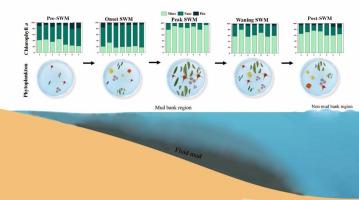Implications of coastal upwelling and mud banks on the structuring of phytoplankton communities in the nearshore waters of Alappuzha, southwest coast of India
IF 8
1区 环境科学与生态学
Q1 ENVIRONMENTAL SCIENCES
引用次数: 0
Abstract
A comprehensive study on phytoplankton dynamics, encompassing chlorophyll a biomass, primary productivity, and community composition and abundance, was conducted in the Alappuzha mud bank region (< 15 m depth) along the southwest coast of India from April to November 2017. This region, recognized as a potential fishing ground for sardines, mackerels and anchovies, is significantly influenced by seasonal hydrographic processes, including thermal stratification, coastal upwelling, and mud bank formation, particularly during the southwest monsoon (SWM). During the pre-SWM period, the region exhibited low chlorophyll a (0.45–2.2 mg m−3) and primary productivity (208.3–365.3 mgC m−3 d−1), primarily driven by nanophytoplankton (2–20 μm), consisting mainly of smaller diatoms (e.g., Trieres mobiliensis, Thalassiosira sp., Pleurosigma sp. etc.) and dinoflagellates (Tripos furca, Prorocentrum micans etc.). In contrast, the peak SWM period exhibited a significant increase in chlorophyll a (3.4–16.9 mg m−3) and primary production (436.3–908.1 mgC m−3 d−1), predominantly contributed by microphytoplankton (20–200 μm), particularly Thalassiosira sp., fuelled by nutrient-rich upwelled waters and calm sea conditions, mainly within mud bank region. Despite the persistent dominance of diatoms (Thalassiosira sp., Skeletonema costatum, Trieres mobiliensis etc.) and certain autotrophic dinoflagellates, phytoplankton chlorophyll a and primary productivity declined markedly during the waning and post-SWM periods due to nutrient exhaustion. Flow cytometry-derived picophytoplankton data revealed a clear dominance of picoeukaryotes (PEUK) and nanophytoplankton across the study region during the Pr. SWM period. However, during the SWM period, a pronounced increase in Synechococcus abundance was observed throughout the study region. Although the mud bank region exhibited higher surface layer turbidity (> 8 NTU) during the SWM, the overall phytoplankton growth, as indicated by chlorophyll a and primary productivity remained unaffected, highlighting the overriding influence of nutrient enrichment over light attenuation.

沿海上升流和泥滩对印度西南海岸Alappuzha近岸水域浮游植物群落结构的影响
对阿拉普扎泥滩地区浮游植物动态进行了全面研究,包括叶绿素A生物量、初级生产力、群落组成和丰度等。从2017年4月到11月,沿着印度西南海岸(深度15米)。该地区被认为是沙丁鱼、鲭鱼和凤尾鱼的潜在渔场,受到季节性水文过程的显著影响,包括热分层、沿海上升流和泥滩形成,特别是在西南季风(SWM)期间。在前swm时期,该区域叶绿素a (0.45-2.2 mg m−3)和初级生产力(208.3-365.3 mgC m−3 d−1)较低,主要由纳米浮游植物(2-20 μm)驱动,主要由较小的硅藻(如Trieres mobiliensis, Thalassiosira sp., Pleurosigma sp.等)和鞭毛藻(Tripos furca, proorocentrum micans等)组成。相比之下,SWM峰值时期叶绿素a (3.4 ~ 16.9 mg m−3)和初级产量(436.3 ~ 908.1 mgC m−3 d−1)显著增加,主要是由微浮游植物(20 ~ 200 μm)贡献的,特别是在富含营养的上升水和平静海况下,主要是在泥岸地区。尽管硅藻(thalassisira sp.、costatum、Trieres mobiliensis等)和某些自养鞭毛藻持续占据优势地位,但由于营养物耗尽,浮游植物叶绿素a和初级生产力在swm末期和后期显著下降。流式细胞术衍生的浮游植物数据显示,在整个研究区域,在Pr. SWM期间,微真核生物(PEUK)和纳米浮游植物明显占优势。然而,在SWM期间,在整个研究区域观察到聚球菌丰度的显着增加。虽然泥滩区地表浊度较高(>;在SWM期间,浮游植物的总体生长(如叶绿素a和初级生产力所示)没有受到影响,突出了营养富集对光衰减的压倒性影响。
本文章由计算机程序翻译,如有差异,请以英文原文为准。
求助全文
约1分钟内获得全文
求助全文
来源期刊

Science of the Total Environment
环境科学-环境科学
CiteScore
17.60
自引率
10.20%
发文量
8726
审稿时长
2.4 months
期刊介绍:
The Science of the Total Environment is an international journal dedicated to scientific research on the environment and its interaction with humanity. It covers a wide range of disciplines and seeks to publish innovative, hypothesis-driven, and impactful research that explores the entire environment, including the atmosphere, lithosphere, hydrosphere, biosphere, and anthroposphere.
The journal's updated Aims & Scope emphasizes the importance of interdisciplinary environmental research with broad impact. Priority is given to studies that advance fundamental understanding and explore the interconnectedness of multiple environmental spheres. Field studies are preferred, while laboratory experiments must demonstrate significant methodological advancements or mechanistic insights with direct relevance to the environment.
 求助内容:
求助内容: 应助结果提醒方式:
应助结果提醒方式:


